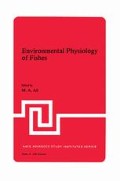Abstract
Teleost fish inhabit a great variety of ecological niches throughout the world where temperature may range from below the freezing point of water to as high as 40°C. There are probably few or none of the 20,000 species that can survive even a slow change through this full range of temperature, but some species have evolved with quite wide temperature tolerance in order to survive in particular temperate or extreme climate habitats. The temperature of the body tissues of most teleost species is generally considered to equilibrate rapidly with any change in water temperature. Changes in the temperature of the tissues cause complicated changes in the rates of metabolic processes and enzymes and other components of the tissue biochemistry can become more or less active. Maximum swimming speed is severely reduced in cold water probably as a result of the effects of low temperature on the biochemical and physiological processes involved in muscle contraction. Whatever the cause the observation is that the twitch contraction of the anaerobic fast white swimming muscle of the fish becomes longer as the muscle is cooled. This paper defines the effect of changing the temperature of the swimming muscle on the muscle contraction time and examines the consequent effect on the maximum swimming speed. Some adaptation and compensation tactics that might help regain the speed lost in cold water are also examined.
Access this chapter
Tax calculation will be finalised at checkout
Purchases are for personal use only
Preview
Unable to display preview. Download preview PDF.
References
Bainbridge, R. (1958) The speed of swimming of fish as related to size and to the frequency and amplitude of tail beat. J. Exp. Biol. 35: 109–133.
Batty, R.S., and Wardle, C.S. (1979) Restoration of glycogen from lactic acid in the anaerobic swimming muscle of plaice Pleuronectes platessa L. J. Fish. Biol. 15: 509–519.
Black, E.C. (1958) Energy stores and metabolism in relation to muscular activity in fishes. In: The Investigation of Power Problems. Ed. P.A. Larkin. Univ. British Columbia, p. 51–67.
Black, E.C., Robertson, A.C. and Parker, R.R. (1961) Some aspects of carbohydrate metabolism in fish. In: Comparative Physiology of Carbohydrate Metabolism in Heterothermic Animals. Ed. A.W. Martin. Seattle, Univ. Washington Press, p. 89–122.
Brill, R.W. and Dizon, A.E. (1979) Effect of temperature on isotonic twitch of white muscle and predicted maximum swimming speeds of skipjack tuna Katsuwonus pelamis. Env. Biol. Fish 4: 199–205.
Carey, F.G. and Teal, J.M. (1969) Regulation of body temperature by the blue fin tuna. Comp. Biochem. Physiol. 28: 205–213.
Dean, J.M. (1976) Temperature of tissues in freshwater fishes. Trans. Am. Fish. Soc. 1976: 709–711.
Hemmings, C.C. (1973) Direct observation of the behaviour of fish in relation to fishing gear. Helgolander wiss. Meeresunters. 24: 348–360.
Hudson, R.C.L. (1973) On the function of the white muscles in teleosts at intermediate swimming speeds. J. Exp. Biol. 58: 509–522.
Hunter, J.R. and Zweifel, J.R. (1971) Swimming speed, tail beat frequency, tail beat amplitude and size in the jack mackerel, Trachurus, symmetricus, and other fishes. U.S. Fish. Bull. 69: 253–266.
Magnusson, J.J. (1978) Locomotion by scombrid fishes: Hydromechanics, morphology and behaviour. In: Fish Physiology. Ed. W.S. Hoar and D.J. Randall. London, Academic Press. Vol. VII, p. 239–313.
Pyatetski, V. Ye. (1970) Kinematic swimming characteristics of some fast marine fish. In: Hydrodynamic Problems of Bionics. Bionica No. 4 1970 translated from Russian, J.P.R.S. 52605, Natl. Tech. Inf. Serv. Washington, D.C. (1971) p. 12–23.
Roberts, J.L. and Graham, J.B. (1979) Effects of swimming speed on the excess temperatures and activities of heart and red and white muscles in the mackerel Scomber japonicus. U.S. Fish. Bull. 76: 861–867.
Wardle, CS. (1971) New observations on the lymph system of the plaice Pleuronectes platessa and other teleosts. J. Mar. Biol. Ass. U.K. 51: 977–990.
Wardle, C.S. (1975) Limit of fish swimming speed. Nature (Lond.) 255: 725–727.
Wardle, C.S. (1977) Effect of size on swimming speeds of fish. In: Scale Effects in Animal Locomotion. Ed. T.J. Pedley. New York, Academic Press, p. 299–313.
Wardle, C.S. (1978) Non-release of lactic acid from anaerobic swimming muscle of plaice Pleuronectes platessa L.: A stress reaction. J. Exp. Biol. 77: 141–155.
Wardle, C.S. and Mojsiewicz, W.M. (in preparation) The effect of size and temperature on muscle contraction time and the maximum swimming speed of fish.
Wardle, C.S. and Reid, A. (1977) The application of large amplitude elongated body theory to measure swimming power in fish. In: Fisheries Mathematics. Ed. J.H. Steele. London, Academic Press, p. 171–191.
Wardle, CS. and Videler, J.J. (1980) Fish swimming. In: Aspects of Animal Movement. Ed. H.Y. Elder and E.R. Trueman. Society of Experimental Biology Seminar Series No. 5. Cambridge Univ. Press, p. 125–150.
Wardle, CS. and Videler, J.J. (1980) How do fish break the speed limit? Nature (Lond.) 284: 445–447.
Webb, P.W. (1978) Fast start performance and body form in seven species of teleost fish. J. Exp. Biol. 74: 211–226.
Author information
Authors and Affiliations
Editor information
Editors and Affiliations
Rights and permissions
Copyright information
© 1980 Springer Science+Business Media New York
About this chapter
Cite this chapter
Wardle, C.S. (1980). Effects of Temperature on the Maximum Swimming Speed of Fishes. In: Ali, M.A. (eds) Environmental Physiology of Fishes. NATO Advanced Study Institutes Series, vol 35. Springer, Boston, MA. https://doi.org/10.1007/978-1-4899-3659-2_20
Download citation
DOI: https://doi.org/10.1007/978-1-4899-3659-2_20
Publisher Name: Springer, Boston, MA
Print ISBN: 978-1-4899-3661-5
Online ISBN: 978-1-4899-3659-2
eBook Packages: Springer Book Archive

